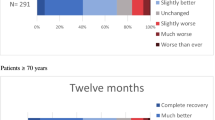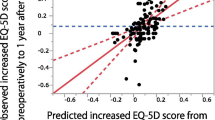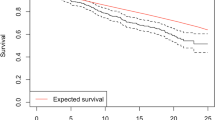Abstract
Purpose
To investigate the quality of life outcomes following surgical treatment of patients with coexisting multiple sclerosis (MS) and cervical stenosis with associated myelopathy (CS).
Methods
A retrospective review of the medical records and of prospectively acquired quality of life (QOL) data was performed for all patients with symptoms of myelopathy and coexisting diagnoses of MS and CS that underwent cervical decompression surgery between 2008 and 2011. The study population was matched (1:4) to a control cohort of patients that did not have MS but presented with similar myelopathic symptoms due to cervical stenosis, were of the same age and gender, and underwent the same cervical decompression procedure within the same year.
Results
Sixty-five patients were reviewed, including 13 in the MS group and 52 in the control group that were followed for an average of 22 and 18 months, respectively. Whereas patients in the MS cohort remained at a Quality-Adjusted Life-Year (QALY) gain of 0.51 both pre- and post-operatively (p = 0.96), patients in the matched control cohort improved from a preoperative QALY of 0.50 to a postoperative QALY of 0.64 (p < 0.0001). The latter represents an improvement that exceeds the minimum clinically important difference. Overall, 70 % of patients in the control group experienced an improvement in QALY, compared to only 54 % in the MS group (p = 0.4).
Conclusion
Patients in the control cohort had clinically and statistically significant improvements in QALY outcomes. Those in the MS cohort averaged no change in QALY. However, only a minority of MS/CS patients had worsening QALY following surgery, and as such surgery may still be considered for these patients. It is imperative that there are preoperative discussions with the MS/CS patient regarding the likelihood that surgery will only provide limited, if any, improvements in QOL.
Similar content being viewed by others
References
Courtney AM, Treadaway K, Remington G, Frohman E (2009) Multiple sclerosis. Med Clin N Am 93:451–476
Rudick RA, Cohen JA, Weinstock-Guttman B, Kinkel RP, Ransohoff RM (1997) Management of multiple sclerosis. N Engl J Med 337:1604–1611
Naci H, Fleurence R, Birt J, Duhig A (2010) Economic burden of multiple sclerosis: a systematic review of the literature. Pharmacoeconomics 28:363–379
Burden of illness of multiple sclerosis (1998) Part I: cost of illness. The Canadian Burden of Illness Study Group. Can J Neurol Sci 25:23–30
Edwards CC 2nd, Riew KD, Anderson PA, Hilibrand AS, Vaccaro AF (2003) Cervical myelopathy. current diagnostic and treatment strategies. Spine J 3:68–81
Klineberg E (2010) Cervical spondylotic myelopathy: a review of the evidence. Orthop Clin N Am 41:193–202
Tracy JA, Bartleson JD (2010) Cervical spondylotic myelopathy. Neurologist 16:176–187
Ransohoff RM (2007) Natalizumab for multiple sclerosis. N Engl J Med 356:2622–2629
Noseworthy JH, Lucchinetti C, Rodriguez M, Weinshenker BG (2000) Multiple sclerosis. N Engl J Med 343:938–952
Brain R, Wilkinson M (1957) The association of cervical spondylosis and disseminated sclerosis. Brain 80:456–478
Burgerman R et al (1992) The association of cervical spondylosis and multiple sclerosis. Surg Neurol 38:265–270
Young WF, Weaver M, Mishra B (1999) Surgical outcome in patients with coexisting multiple sclerosis and spondylosis. Acta Neurol Scand 100:84–87
Bashir K, Cai CY, Moore TA 2nd, Whitaker JN, Hadley MN (2000) Surgery for cervical spinal cord compression in patients with multiple sclerosis. Neurosurgery 47:637–642 (discussion 642–643)
Arnold PM, Baek PN, Bernardi RJ, Luck EA, Larson SJ (1997) Surgical management of nontuberculous thoracic and lumbar vertebral osteomyelitis: report of 33 cases. Surg Neurol 47:551–561
Harris PA et al (2009) Research electronic data capture (REDCap)—A metadata-driven methodology and workflow process for providing translational research informatics support. J Biomed Inform 42:377–381
Nurick S (1972) The pathogenesis of the spinal cord disorder associated with cervical spondylosis. Brain 95:87–100
Jansson K-A, Németh G, Granath F, Jönsson B, Blomqvist P (2005) Health-related quality of life in patients before and after surgery for a herniated lumbar disc. J Bone Joint Surg Br 87:959–964
Hansson TH, Hansson EK (2000) The effects of common medical interventions on pain, back function, and work resumption in patients with chronic low back pain: a prospective 2-year cohort study in six countries. Spine 25:3055–3064
McDonough CM et al (2005) Comparison of EQ-5D, HUI, and SF-36-derived societal health state values among spine patient outcomes research trial (SPORT) participants. Qual Life Res 14:1321–1332
The EuroQol Group (1990) EuroQol—a new facility for the measurement of health-related quality of life. Health Policy 16(3):199–208
McDonough CM et al (2011) A longitudinal comparison of 5 preference-weighted health state classification systems in persons with intervertebral disk herniation. Med Decis Making 31:270–280
Kepler CK et al (2012) Cost-utility analysis in spine care: a systematic review. Spine J 12:676–690
Johnson JA, Coons SJ, Ergo A, Szava-Kovats G (1998) Valuation of EuroQOL (EQ-5D) health states in an adult US sample. Pharmacoeconomics 13:421–433
Badia X et al (2001) Using the EuroQol-5D to measure changes in quality of life 12 months after discharge from an intensive care unit. Intensive Care Med 27:1901–1907
Parker SL, Godil SS, Shau DN, Mendenhall SK, McGirt MJ (2013) Assessment of the minimum clinically important difference in pain, disability, and quality of life after anterior cervical discectomy and fusion: clinical article. J Neurosurg Spine 18:154–160
Noonan CW, Kathman SJ, White MC (2002) Prevalence estimates for MS in the United States and evidence of an increasing trend for women. Neurology 58:136–138
Compston A, Coles A (2002) Multiple sclerosis. Lancet 359:1221–1231
LaRocca H (1988) Cervical spondylotic myelopathy: natural history. Spine 13:854–855
Alschuler KN, Ehde DM, Jensen MP (2013) The co-occurrence of pain and depression in adults with multiple sclerosis. Rehabil Psychol 58:217–221
Siegert RJ, Abernethy DA (2005) Depression in multiple sclerosis: a review. J Neurol Neurosurg Psychiatr 76:469–475
Mitchell AJ, Benito-León J, González J-MM, Rivera-Navarro J (2005) Quality of life and its assessment in multiple sclerosis: integrating physical and psychological components of wellbeing. Lancet Neurol 4:556–566
Bermejo PE, Oreja-Guevara C, Díez-Tejedor E (2010) Pain in multiple sclerosis: prevalence, mechanisms, types and treatment. Rev Neurol 50:101–108
Telci Aslan (2012) E. & Karaduman, A. Effects of three different conservative treatments on pain, disability, quality of life, and mood in patients with cervical spondylosis. Rheumatol Int 32:1033–1040
Fogarty E et al (2013) Relating health-related quality of life to disability progression in multiple sclerosis, using the 5-level EQ-5D. Mult Scler. doi:10.1177/1352458512474860
Glanz BI et al (2012) Work productivity in relapsing multiple sclerosis: associations with disability, depression, fatigue, anxiety, cognition, and health-related quality of life. Value Health 15:1029–1035
Owens GM, Olvey EL, Skrepnek GH, Pill MW (2013) Perspectives for managed care organizations on the burden of multiple sclerosis and the cost-benefits of disease-modifying therapies. J Manag Care Pharm 19:S41–S53
Noyes K et al (2011) Cost-effectiveness of disease-modifying therapy for multiple sclerosis: a population-based study. Neurology 77:355–363
Fehlings MG et al (2012) Is surgery for cervical spondylotic myelopathy cost-effective? A cost-utility analysis based on data from the AOSpine North America prospective CSM study. J Neurosurg Spine 17:89–93
Nortvedt MW, Riise T, Myhr K-M, Nyland HI (1999) Quality of life in multiple sclerosis measuring the disease effects more broadly. Neurology 53:1098–1103
Benito-León J, Morales JM, Rivera-Navarro J, Mitchell A (2003) A review about the impact of multiple sclerosis on health-related quality of life. Disabil Rehabil 25:1291–1303
Benito-León J, Mitchell AJ, Rivera-Navarro J, Morales-González JM (2013) Impaired health-related quality of life predicts progression of disability in multiple sclerosis. Eur J Neurol 20:79–86
Conflict of interest
None.
Author information
Authors and Affiliations
Corresponding author
Additional information
No grants, technical or corporate support were received in conducting this study or writing this manuscript. IRB approval (Study # 11-285) was obtained prior to start of study.
Rights and permissions
About this article
Cite this article
Lubelski, D., Alvin, M.D., Silverstein, M. et al. Quality of life outcomes following surgery for patients with coexistent cervical stenosis and multiple sclerosis. Eur Spine J 23, 1699–1704 (2014). https://doi.org/10.1007/s00586-014-3331-x
Received:
Revised:
Accepted:
Published:
Issue Date:
DOI: https://doi.org/10.1007/s00586-014-3331-x




